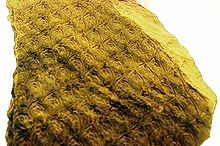Paleobotany
Paleobotany is the science of fossil plants. It is an interdisciplinary field of research from paleontology and chorology.
The first plants colonized the land already in the Ordovician. There are finds of well-preserved plant remains from the late Silurian and especially from the Lower Devonian. One of the most important sites is Rhynie in Scotland, where the first fossils of the 400 million year old land plant Rhynia were found. Like today's ferns, these plants belong to the spore family.
In the Upper Devonian the first seed plants appeared. From the Carboniferous many finds of the plants that formed the so-called coal forests are known. Typical forms such as calamites or lepidodendrons can often be found in coal seams. The first finds of conifers date from the time of the Westfalian (Upper Carboniferous).
The boundaries of the palaeobotanical periods do not always coincide with those of palaeozoology, since the development of the animal world is always dependent on the evolution of plants and therefore only reaches its greatest development subsequently. The geologist Kurd von Bülow therefore proposed in 1941 an orientation on the development of the plant world for the demarcation of the Earth Ages. This corresponds to the still today valid and in the German-speaking countries generally recognized division. However, it could not completely assert itself in the English-language palaeobotanical literature. Since fossil plant parts were often missing as time markers, mainly animal fossils were used, which is why the zoological classification is often preferred.

Furthermore, palaeobotany or archaeobotany, as a neighbouring discipline of archaeology, deals with the useful plants of man.

Fossil of the scale tree Lepidodendron aculeatum
Search within the encyclopedia